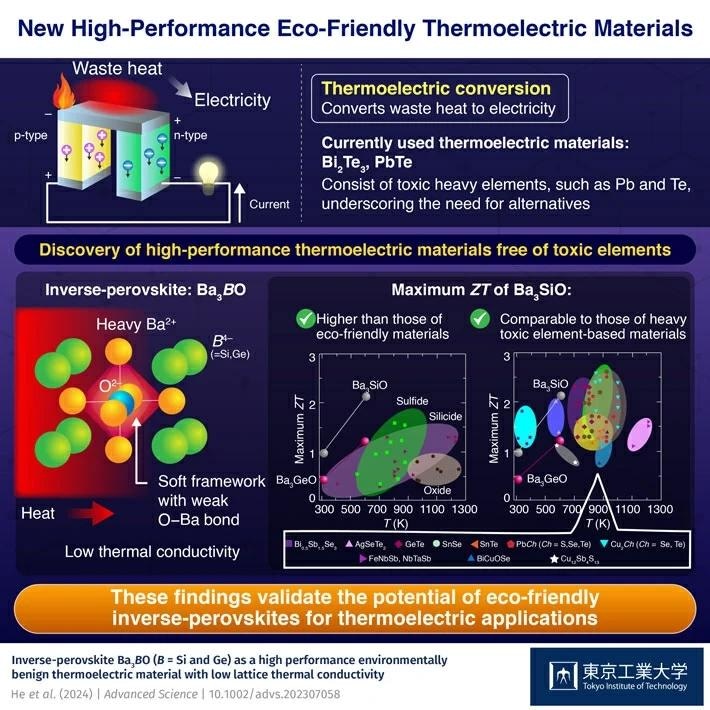Scientists at Tokyo Tech have reported on inverse-perovskites that are environmentally friendly and have a high-energy conversion efficiency.

Image Credit: Tokyo Institute of Technology
These materials have the potential to be used as thermoelectric materials (TEMs) in real-world applications. Addressing the limitations typically faced with TEMs, such as insufficient energy conversion efficiency and environmental toxicity due to heavy elements, the new TEMs provide a suitable alternative to TEMs based on toxic elements with better thermoelectric properties than conventional eco-friendly TEMs.
The world requires improved waste-energy harvesting systems and cooling systems for electronic devices because thermoelectric materials (TEMs), which can convert thermal energy to electrical energy and vice versa, are becoming a necessary component of everyday life.
A dimensionless figure of merit (ZT), which is a product of the power factor (PF) and the inverse of thermal conductivity (κ), determines the energy conversion efficiency of thermoelectric meters (TEMs).
If a high-performance TEM has high PF and low κ, it will show a high ZT. These requirements have been met by a number of high-performance heavy metal chalcogenide-based TEMs that scientists have developed over time, including PbTe and Bi2Te3. Although these materials were perfect for converting energy, their practical uses were limited because they contained heavy elements that were harmful to both the environment and living things, like tellurium (Te) and lead (Pb).
However, despite the fact that oxide-based TEMs, like SrTiO3, have a lot of benefits, like being non-toxic and having a lot of natural resources, their high κ has limited their ZT.
To solve this, a research group headed by Tokyo Institute of Technology Associate Professor Takayoshi Katase investigated effective but environmentally safe toxic-element-free TEMs. The researchers presented “inverse”-perovskite-based high ZT TEMs with the chemical formula Ba3BO, where B stands for silicon (Si) and germanium (Ge), in a recent study that was published in Advanced Science.
Unlike normal perovskites, such as SrTiO3, the positions of cation and anion sites are inverted in inverse-perovskites Ba3BO. So, they contain a large amount of the heavy element, Ba, and their crystal structure is formed by a soft flamework made up of weak O-Ba bonds. These characteristics realize the low κ in inverse-perovskites.
Takayoshi Katase, Associate Professor and Head, MDX Research Center for Element Strategy, International Research Frontiers Initiative, Tokyo Institute of Technology
Katase elaborates on the standout properties of the materials.
It was explained by the research team that the synthesized bulk polycrystals of Ba3BO have a κ of 1.0–0.4 W/mK at a T of 300–600 K, which is significantly lower than bulks of PbTe and Bi2Te3. Consequently, at T = 300–623 K, the Ba3BO bulks show a relatively high ZT of 0.16-0.84.
In addition to the encouraging experimental results, the group performed theoretical calculations that, by optimizing hole concentration, predicted a potential maximum ZT of 1.21 for Ba3GeO and 2.14 for Ba3SiO at T = 600 K. The maximum ZT of these non-toxic TEMs is comparable to that of the toxic heavy element TEMs in the same temperature range and significantly higher than that of other environmentally friendly TEMs.
The team also explained that Ba3BO’s high ZT is caused by both its high PF: B ion, which typically behaves as a negatively charged anion but as a positively charged cation, and its low κ. High PF is attained through carrier transport, which is the responsibility of the B anions.
To sum up, this study confirms that the recently developed Ba3BOs have the potential to be an environmentally friendly and highly effective replacement for traditional heavy element-based TEMs that are hazardous. According to the findings, inverse-perovskites represent a viable alternative for creating sophisticated TEMs that are safe for the environment.
We believe that our unique insight into designing high ZT materials without using toxic elements would have a strong impact on the materials science and chemistry communities as well as among innovators looking to expand the horizon of thermoelectric material applications beyond laboratories into our everyday life.
Takayoshi Katase, Associate Professor and Head, MDX Research Center for Element Strategy, International Research Frontiers Initiative, Tokyo Institute of Technology
Journal Reference:
He, X., et al. (2024). Inverse-Perovskite Ba3BO (B = Si and Ge) as a High Performance Environmentally Benign Thermoelectric Material with Low Lattice Thermal Conductivity. Advanced Science. https://doi.org/10.1002/advs.202307058